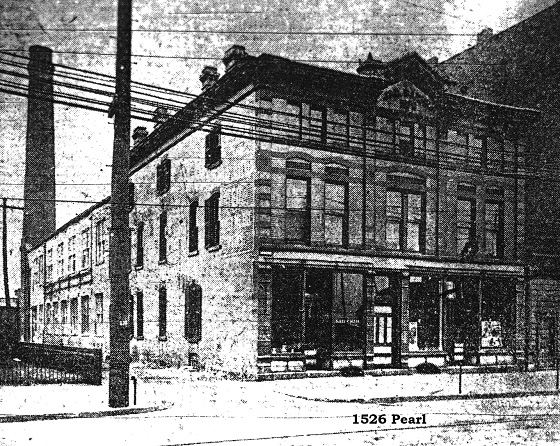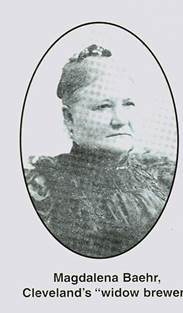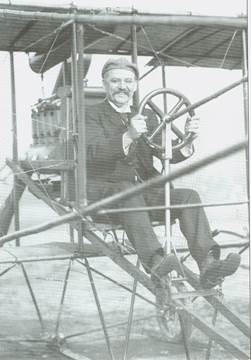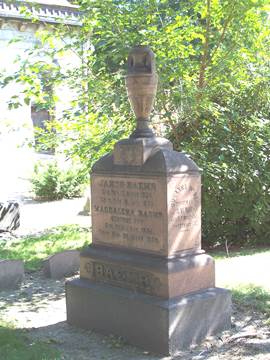Jacob Baehr 1824 - 1873
Magdalena Baehr 1834 - 1909
Brewing with Integrity
Jacob Baehr’s brewery was a typical establishment of its day. Although brewery work was no easy affair under any circumstances, Baehr must have run an exceptionally tight ship. No employee at the brewery was permitted to engage in “lewd talk” while on duty, and Baehr employed no man who was not a proven, regular church-goer. Perhaps even more revealing was Baehr’s strict policy that no beer carrying the Baehr name would be sold to anyone who was known to use alcohol in any but a moderate manner. In a time when beer was primarily a working-class indulgence (and, indeed, a time when the working class was not known for its moderation), Baehr’s righteous business philosophies were not standard practice. The old brewer’s strict Mennonite upbringing may have outweighed his entrepreneurial drive.

Jacob Baehr, a native of Heidelberg came to America in 1850 and found his first employment as a cooper in New York City. At the behest of a brother living in Cleveland, who called the City a “Second Heidelberg”, Baehr came to the shores of Lake Erie and established a cooperage on Carroll Avenue. In 1857, Baehr was encouraged by friend John Leisy to move to Iowa and join in the Leisy & Brothers Brewery there. Although business was good in Iowa, Baehr returned to Cleveland in 1866, apparently preferring the urban life. Baehr employed his long experience as a brewer, establishing a small lager beer brewery on Pearl Street (W. 25th Street) near Church Avenue in 1866. While Baehr attended to the duties of the brewery, his wife ran the small saloon in the front portion of the building. The entire Baehr family, which numbered no less than ten, lived on the upper floor of the brewery.
The following historical biography can be found in Breweries of Cleveland by Carl H. Miller.
When Isaac, August and Henry Leisy first came to Cleveland in 1873, they were likely to have previous knowledge of the city’s promising beer market. Among the partners in the old brewery back in Keokuk, Iowa, was fellow German Jacob Baehr, who had left Iowa in 1866 to establish a brewery in Cleveland. Henry Leisy, in fact, ultimately married one of Baehr’s daughters. There is little doubt of Baehr’s success in Cleveland had reached the Leisys prior to Isaac’s initial visit for the Brewer’s Congress. And, indeed, although Jacob Baehr passed away just weeks before Isaac’s trip to Cleveland, the Baehr name was well-known in Cleveland’s brewing circles for many years.

In the early days, it was a common occurrence in the operation of a German-owned brewery, that after the passing of its proprietor, the widow assumed management of the business. The death of Jacob Baehr in 1873, did not spell ruin for his brewery. Under the name of Mrs. Jacob Baehr’s Brewery, the widow Magdalena Baehr took over supervision of the business and, for the next 25 years, remained at its head. A biographer paid tribute to the ambitious widow:
With eight children, the youngest not even a year and a half old, and suddenly without a husband, Mrs. Baehr admirably united the role of loving mother with that of shrewd business woman. Busy from early morning until late, looking after all the details of the brewery, and never leaving an eye from the raising of her children, Mrs. Baehr achieved some surprising results. From 3,000 barrels of beer that were made in 1873, she took the yearly sales of the brewery to 25,000 barrels, personally making sure that every drop of beer reached its destination in the city.
Mrs. Baehr produced a selection of six different brews: Vienna, Kulmbacher, Pilsener, Franciscaner, Lager and Extra Export. Despite its name the Extra Export brand was probably not shipped out of town; Mrs. Baehr confined her business exclusively to the City of Cleveland, believing strongly in the “home industry principle”. Beer which was termed “export” connoted a premium variety and was offered by many brewers who engaged in little or no shipping.
The 1890s seemed to have been a particularly progressive decade for Mrs. Baehr’s brewery. The Western Brewer reported in 1892 that several improvements were being made at the brewery, among them a new brewhouse, new stockhouse, improved racking (kegging) facilities, enlarged grain storage, and a new wash house. In 1894 Mrs. Baehr, who generally did not involve the brewery in a great deal of promotional activity, advertised her bottled beer in Cleveland Town Topics, a magazine published exclusively for the city’s social elite. Indeed, Mrs. Baehr’s saloon adjacent to the brewery had become a fashionable spot. By virtue of her perseverance and independence, Mrs. Baehr won the admiration and friendship of many prominent Clevelanders, including Senator Marcus Hanna and local politician James Barnett. It was this exposure to political circles that sparked one of Mrs. Baehr’s sons, Herman C. Baehr, to pursue a political career that culminated in his serving as mayor of Cleveland from 1910 to 1912. Baehr succeeded Mayor Tom L. Johnson, regarded as one of the great urban reformers of his time. Johnson’s defeat by Baehr – the result of a hotly contested election – made national headlines. Interestingly, Johnson was the political arch rival of Marcus Hanna, a close family friend of the Baehrs.
In 1898, the aging Mrs. Baehr decided to sell the family brewery to the recently organized Cleveland & Sandusky Brewing Company. Sons Emil and Herman C. Baehr were kept on at the brewery as brewmaster and manager, respectively. Herman was placed on the board of directors of the Cleveland & Sandusky company. Mrs. Baehr spent her final years living on Cleveland’s west side and engaging in philanthropic activities. In 1901, the Cleveland & Sandusky Brewing Company closed the Baehr plant and transferred its production to the Phoenix Brewery at Columbus and Willey Streets, thereafter known as the Baehr-Phoenix branch of the combine.”
The following historical biography can be found in The Encyclopedia of Cleveland History:
Baehr, Hermann C.(16 Mar. 1866 – 4 Feb. 1942), a businessman and politician, served as county recorder (1904-1909) and mayor of Cleveland (1910-1912(. He was an officer of the Cleveland & Sandusky Brewing Corp., vice president of the Forest City Savings & Loan, and a director of Cleveland Trust Bank. Baehr was born in Keokuk, Iowa, the son of Jacob and Magdalena (nee Zipf) Baehr. His parents had lived in Cleveland from 1850-1862 before moving to Iowa and returned here shortly after the Civil War. He was educated in public schools, quitting school at 14 to join his father’s brewing company. He later attended Lehman’s Scientific Academy at Worms-on-the-Rhine, and graduated from the First Scientific Station of New York in 1887. Baehr received an M.B degree. After returning to Cleveland Baehr was an official of the Baehr Brewing Company, which his father had founded and became secretary and treasurer of the Cleveland & Sandusky Brewing Corp. when it took over Baehr Brewing. He married Rose Schulte in 1898. Interested in Republican party politics, Baehr was elected county recorder, serving 5 years, and defeated Tom L. Johnson for mayor in 1909. He declined to seek reelection in 1912, becoming first vice president and director of the Forest City Savings & Trust Company. He became a director of the Cleveland Trust Bank when it took over Forest City Savings. He was also president of the Langenau Mfg. Co. Baehr had no children and died in Los Angeles, CA.

